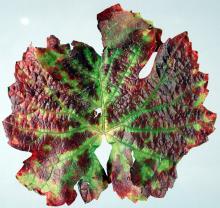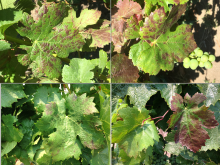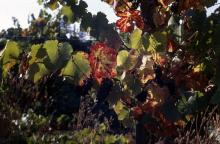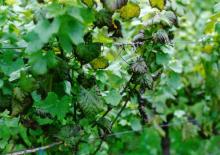See:
Grape (Vitis spp.) - Grapevine Red Blotch Disease
Cause The viruses associated with grapevine leafroll disease and corky bark disease have been found in Oregon and Washington vineyards. Leafroll disease spreads through insect vectors, while corky bark either does not move in vineyards or moves very slowly. Of the viruses associated with leafroll disease, GLRaV-3 was the virus most often found in surveys. Mealybug and scale insects transmit this virus. The grape mealybug is common in the PNW. Gill's mealybug is also a known vector of leafroll and is found in southern Oregon. Therefore, it is critical that growers use only vines tested to be free of these viruses or certified plants when establishing vineyards. All grapes entering Oregon, Washington, and Idaho are under quarantine and must be certified free of several viruses, including leafroll, red blotch, fanleaf virus, and corky bark disease (Grapevine virus A and B). As more vines are grafted onto rootstocks to guard against Phylloxera, these viruses will become more damaging if they get established. Leafroll will cause symptoms in ungrafted plants but may cause graft union necrosis in grafted plants as will corky bark. Vitis vinifera cultivars that carry corky bark do not show symptoms until they are grafted onto American rootstocks.
Rupestris stem pitting-associated virus (RSPaV) is in Oregon and Washington and is not listed as a quarantined virus in PNW states. It remains an important component of the Washington certification program, although California, Canada, France, and Germany do not have this virus listed as restricted in their certification programs. It is generally accepted that RSPaV is a minor virus, though its effect in mixed or multiple infections is unclear.
Seven nematode-transmitted viruses (Nepoviruses) are known to infect grapevines in North America including: arabis mosaic virus, blueberry leaf mottle virus, grapevine fanleaf virus, peach rosette mosaic virus, tobacco ringspot virus, tomato black ring virus, and tomato ringspot virus. In a survey of vineyards in Oregon known to have Xiphinema americanum nematodes, only tomato ringspot virus was detected and then only in a few vineyards in the Willamette Valley. However, Tobacco ringspot virus and grapevine fanleaf virus have been detected in several vineyards the Yakima Valley in Washington in plants exhibiting symptoms of fanleaf degeneration/decline. It is not expected that fanleaf would be a problem in the PNW, since the vector, X. index, has not been found in surveys in Oregon, Idaho and Washington. Similarly, the nematode vector of arabis mosaic virus is not widely distributed in North America. All grapevines entering Oregon and Washington must be certified free of these Nepoviruses.
Grapevine red blotch virus (GRBV) was first reported in 2012. The discovery occurred when grapevines with red leaf symptoms that tested negative for grapevine leafroll-associated viruses (1-10) (GLRaV) were analyzed for possible new viruses. GRBV is the type member of the Grablovirus genus, in the family Geminiviridae that is graft-transmissible. All grapevines entering Oregon, Idaho and Washington must be certified free of the GRBV.
Symptoms Leafroll, also called red leaf or white emperor disease, reddens the lower foliage of dark-fruit cultivars in September and October. Foliage of white-fruit cultivars may yellow at this time. Other symptoms include delayed foliation in spring, downcurling of leaves, production of fewer, smaller clusters of berries lower than normal in soluble solids, and less vigorous vine growth in adverse circumstances. The grapes of red-fruit cultivars do not color well when infected with GLRaV. Potassium deficiency symptoms mimic many of the symptoms caused by GLRaV. The vein clearing associated with leafroll disease can be used to discriminate it from similar leaf discoloration caused by other stress factors.
Grapevine Red Blotch Disease- In red winegrape cultivars, these symptoms initially appear as small, irregular red-colored areas between major veins on mature leaves at the basal portion of the canopy of affected vines, and symptoms develop on leaves further up the canes during late season. The discolored areas on the leaves expand and coalesce with time to become reddish or reddish-purple blotches that are strikingly apparent towards the end of the season. In some cultivars the veins become red in contrast to the green veins usually observed with grapevine leafroll disease. However, the symptoms of this disease can be confused with grapevine leafroll disease. At this time there seems to be considerable variation in degree of reddening depending on cultivar and rootstock. Reports of the impact of GRBV on changes in fruit quality vary widely with sugar reductions of 0 to 5 Brix reported as well as changes in the pH and anthocyanin (color) of the juice. White cultivars positive for the virus did not exhibit the symptom of reddening of leaves, and in the case of Chardonnay, leaves developed yellowing and some necrosis late in the season; juice was affected similarly to red grapes.
All of the Nepoviruses are associated with poor fruit set in grapevines. Loose clusters and abundant small shot berries characterize virus infection. Tomato ringspot virus can cause a graft union necrosis in grafted vines, and can result in declining plants leading to plant death in 3-5 years.
Fanleaf symptoms are best seen early in the growing season. New growth on infected vines often is dwarfed on weak, flattened, crooked canes. Young leaves are mottled and deformed, showing excessive dentation (abnormally sawtoothed leaf edge) and a broad sinus at the petiole. Together, these symptoms resemble a partially closed fan, much like 2,4-D injury. Some strains cause bright yellow patterns on leaves, often without the leaf deformation associated with other grapevine fanleaf virus strains. Grapevine yellow vein virus is another strain, it produces distinct yellowish or whitish bands along leaf veins most of the season. The distribution of the yellow vein strain appears to be very limited at this time.
Corky bark causes an incompatibility to develop at the graft union. Leaf symptoms resemble those of leafroll but are more severe on some rootstocks. Leaves on cultivars such as Pinot noir may develop a yellow chlorosis before they turn red. The wood at the base of canes may swell slightly, causing the bark to split. Depending on the cultivar, various wood grooving also may occur. On self-rooted grapevines, the symptoms of corky bark are very mild.
Rupestris stem pitting-associated virus is suspected of causing a slow decline of Vitis vinifera. Affected vines are smaller than healthy ones, but leaves appear normal. Delayed ripening and reduced yields have been associated with this problem. Rootstocks of V. rupestris and its hybrids develop pitting in the xylem, observed on woody tissues after bark is removed. Easily confused with corky bark symptoms. On self-rooted grapevines, RSPaV intensifies the symptoms associated with leafroll disease.
Cultural control
Plant healthy stock. Only plants certified free of grapevine fanleaf, leafroll, and grapevine red blotch can be shipped into Oregon, Washington, and Idaho. Be sure to ask the nursery for certified plants when purchasing vines. Most reputable nurseries have certified rootstocks and cultivars available. However, the nursery must carry plants that are certified by either the California or Washington state certification programs due to their programs aligning with the grape quarantines in each of the PNW states.
- Grapevine fanleaf virus, tobacco ringspot virus and tomato ringspot virus are transmitted in soil by certain nematodes of the genus Xiphinema but the vector of fanleaf (X. index) has not been found in the PNW. Old grapevine roots infected with fanleaf persist many years in soil and serve as reservoirs of these viruses. Therefore, do not replant grapes in infested ground for 10 years unless you use special fallowing procedures and then fumigate deeply.
- Control of mealybugs and scale insects is important to limit spread of leafroll. See the PNW Insect Management Handbook for details.
- Remove and destroy virus-infected vines. For leafroll, this requires removal of roots since mealybugs may be harbored on roots in the soil for long periods of time.
- Maintain vineyard health and vigor through good nutrition, proper irrigation, and manage crop load to reduce physical and environmental stresses.
References Golino, D., Uyemoto, J.K., and Goheen, A.C. 1992. Grape virus diseases, pp. 101-109. In: Grape Pest Management, Second Edition. D.L. Flaherty et al (eds.). University of California: Oakland, CA.
Bahder, B.W., Alabi, O., Poojari, S., Walsh, D.B., and Naidu, R.A. 2013. A survey for grapevine viruses in Washington state 'Concord' (Vitis x labruscana L.) vineyards. Online. Plant Health Progress doi:10.1094/PHP-2013-0805-01-RS.
Sudarshana, M.R., Perry, K.L., and Fuchs, M.F. 2015. Grapevine red blotch-associated virus, an emerging threat to the grapevine industry. Phytopathology 105:1026-1032.
Walker, L., Bagewadi, B., Schultz, A., and Naidu, R.A. 2015. First report of tobacco ringspot virus associated with fanleaf disease in a Washington state vineyard. Plant Disease 99:1286.





